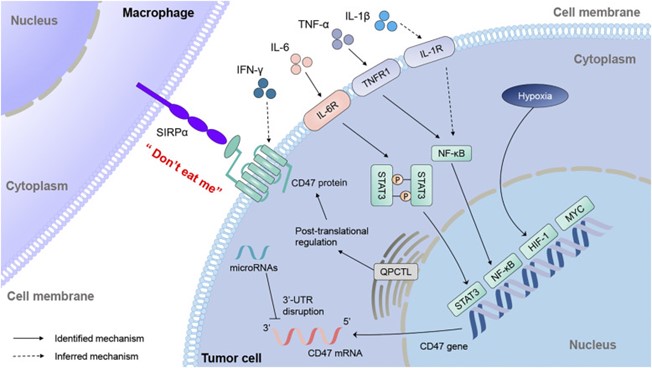3 Relationship Between CD47-related Signaling Pathways and Diseases
3.1 Cancer
CD47 is highly expressed on the surface of many kinds of tumor cells, which, as a signal molecule of “don’t eat me”, interacts with SIRPα on the surface of macrophages to prevent tumor cells from being swallowed and cleared and enhance tumor viability. Therefore, targeting CD47-SIRPα interaction may be a new strategy for tumor therapy. At present, anti-tumor therapy mainly targets the CD47-SIRPα axis, and a variety of therapeutic drugs have been in clinical trials, including conventional antibodies, fusion proteins, and bispecific molecules, which block CD47 or SIRP α respectively.
Fig. 4. The regulatory mechanisms of CD47 expression. (Translational Oncology)
3.2 Cardiovascular Diseases
The main clinical manifestations of cardiovascular diseases include stroke, macular degeneration, peripheral vascular disease, hypertension, heart, and other key organ failure, heart disease, and poor wound healing. The main cause is acute or subacute decrease of blood flow and tissue hypoperfusion, and the damage of NO signaling pathway in vascular cells is the major factor leading to cardiovascular diseases. During senescence, endogenous NO synthesis decreased while TSP1 expression increased. As mentioned earlier, the interaction between TSP1 and CD47 can inhibit the NO/cGMP signaling pathway. Therefore, inhibition of TSP1-CD47 interaction can improve NO signaling pathway and reduce the occurrence of cardiovascular diseases.
Kojima et al. found that pathological or dead smooth muscle cells and macrophages could be eliminated in vitro by anti-CD47 antibody, MIAP410. In different kinds of atherosclerotic mice, anti-CD47 antibody was used to block CD47 to significantly prevent the accumulation of arterial plaques and restore the clearance of diseased vascular tissue to normal.
3.3 Autoimmune Diseases
Studies showed that SIRPα and CD47 are associated to the formation of autoimmune diseases related to Th1 or Th17 cells, such as experimental autoimmuneencephalomyelitis (EAE), bacterial or collagen-induced arthritis, contact hypersensitivity, colitis, and Crohn’s disease. CD47-SIRPα interaction can regulate the function of DCs, especially migration and antigen presentation, which is necessary for activating autoreactive Th1 and Th17 cells. Interfering with the interaction of CD47-SIRPα can inhibit the development of arthritis, colitis, and Crohn’s disease, but in EAE it can aggravate autoimmunity. Other studies indicated that SIRPα deletion mice or anti-SIRPα antibody (P84) can significantly reduce the level of inflammation, bone erosion, and arthritis symptoms in type Ⅱ collagen arthritis mice.
3.4 Hemophagocytic Lymphohistiocytosis
One of the typical characteristics of hemophagocytic lymphohistiocytosis (HLH) is the enhancement of hemophagocytic function, mainly due to the impaired pathogen scavenging function of cytotoxic lymphocyte (CTL) and NK cells, resulting in excessive proliferation of macrophages and increase of hemophagocytes. The expression of CD47 in CD34+ CD38- HSCs of HLH is down-regulated, and the phagocytosis of macrophages is enhanced, resulting in hemophagocytic syndrome.
4 Summary
CD47 interacts with its two ligands, TSP1 and SIRPα, and participates in a variety of signal pathways, as well as a variety of physiological functions and pathological processes. Therefore, targeting CD47 provides a new method for disease treatment. At present, the treatment of targeting CD47 mainly applies in the field of anti-tumor, and the major treatment strategies are blocking antibody, recombinant fusion protein, antisense RNA, and small molecule inhibitor. There are many studies on blocking antibody and recombinant fusion protein, which mainly target CD47 and its two ligands SIRP α and TSP1. At present, the anti-tumor drugs targeting CD47 in phase I clinical trials include Hu5F9-G4, CC-90002, TTI-621, and ALX148, among which TTI-621 is a soluble recombinant SIRP α-Fc fusion protein with better penetration ability and tissue distribution, lower affinity with red blood cells, and higher safety. Small molecular inhibitors, such as peptides, have a short half-life in vivo and are easy to be hydrolyzed by enzymes, so they are difficult to play a therapeutic role, but can be used to design effective and stable mimic peptides, such as TSP-1 mimetic peptides, and to recognize their receptor CD36. Antisense RNA can block the translation of CD47 mRNA, thus inhibiting the expression of CD47 protein. It is also expected to become an effective means to target CD47.
In short, CD47 is not only a hot topic in oncology, but also plays an important role in other diseases. The development of drugs targeting CD47 is expected to provide a new strategy for the disease treatment.

